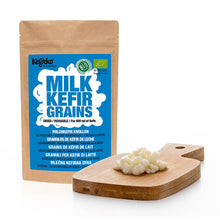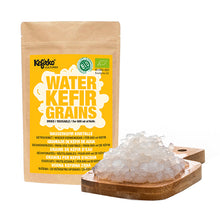Info: Water or Milk- Based Kefir Starter, in 2 Types of Small Packets
A terrific source of beneficial bacteria which can help your gastrointestinal health and the immune system, Kefir is similar to yogurt in that it can be consumed on its own, flavoured in a variety of ways, or added to smoothies, cereals, and other recipes ... but kefir has about three times the amount of probiotic cultures as yogurt!
Info: Water or Milk- Based Kefir Starter, in 2 Types of Small Packets
A terrific source of beneficial bacteria which can help your gastrointestinal health and the immune system, Kefir is similar to yogurt in that it can be consumed on its own, flavoured in a variety of ways, or added to smoothies, cereals, and other recipes ... but kefir has about three times the amount of probiotic cultures as yogurt!
Product Notes:
Rather than having to keep buying it at the store, now you can make kefir at home using a starter culture, which can be reused indefinitely with the proper care.
Aviva is your source for kefir starter in Winnipeg. Unlike some other starters, these kefir grains are suitable for shipping, as well. Two types are available: one for making milk-based kefir (which draws on the sugars within the milk itself to support the fermentation process), and one for water-based cultures (which requires sugar to be added to work). Each packet of dried grains can make up to 600 ml of kefir at a time, and with proper care, they can be reused almost indefinitely.
The product photos show the packets they come in (except ours sometimes also say "Organic" at the top), along with what the grains will look like after they have been reconstituted in their respective liquids. (Initially they will be much smaller than that.)
Suggested Usage:
How to Reconstitute Freeze-Dried Milk Kefir Grains:
1) Place the freeze-dried milk kefir grains in a suitable glass jar (such as the Kefirko jar), and add 1 cup of fresh milk, and leave at room temperature (18-24 Celsius). If not using the Kefirko jar, cover the jar with something like a coffee filter or a tightly woven towel attached with a rubber band, to keep insects out.
2) After 24 hours, strain the grains (using the plastic sieve or strainer lid on Kefirko jar, e.g.), discard that batch of milk, and wash the grains with lukewarm water.
3) Put the grains back in the (washed) jar, add a fresh cup of milk, and leave them for another 24 hours.
4) Repeat this for seven to fourteen days* until the grains are reactivated, and have grown to the point that they can fill up the measuring cup integrated into the top of the Kefirko jar lid. The clear sign of reactivation of the grains is whether the milk thickens overnight (versus if it just stays the same consistency of liquid as when it was first poured in) (*After the first few days of soaking, cover the jar with a clean cap (if you haven't been already) -- but not too tight, so as to allow gas from the fermentation process to escape. Again, you can use the Kefirko jar for this, which allows a slightly opened top lid.).
5) They are they ready to be used to make milk kefir, following the rest of the instructions in the package or with your kefir maker. It may take a few batches for them to reach ideal potency.
How to Revive Dehydrated Water Kefir Grains (Method 1):
1) In a suitable glass jar, add the dehydrated water kefir grain mix; two cups of unchlorinated water (i.e., either filtered or bottled water); and a tablespoon of freshly squeezed lemon juice. (If you don't have access to unchlorinated water, let your tap water stand in an open bowl (maybe covered with a cheese cloth to keep insects out) for up to 24 hours to let the chlorine evaporate.)
2) Seal the jar, and let it soak for 3 hours.
3) Strain the reconstituted grains, then they are ready to use to make water kefir, according to the Recipe directions given on the package (which are much like Method 2 below).
But if you do not want to use them for that right away, or when not using them for fermenting, please keep them refrigerated for up to two weeks, between uses. Either way (from the initial dehydration stage or from cold storage), it may take a few batches for them to reach ideal potency.
How to Revive/Activate Dehydrated Water Kefir Grains (Method 2):
1) Dissolve 30 grams of sugar (at least half of it unrefined sugar such as brown sugar with the minerals still in) in 300 ml of non-chlorinated water (or in tap water that's been left in an open bowl long enough for the chlorine to evaporate away) in a suitable glass jar. (If you do not have any unrefined sugar, add some molasses, or some dried fruit with lots of minerals in it, like figs or ginger root.)
2) Add the water kefir grains, cover, and let it ferment at room temperature (20 to 24 Celsius) for three to four days.
3) Strain the sugar water out, rinse the grains in room temperature unchlorinated water, and repeat steps 1 & 2 up to five to seven more times until there are signs of activity - but only ferment it for 2 days between new sugar water solutions.
The three main signs for them being active enough to go ahead and use for real include: developing the distinctive kefir smell to an intense degree; emitting bubbles; and sucking so much sugar out of the water that the remaining liquid hardly tastes sweet at all. When they're fully activated, they become more gelatinous, and the packet's original collective weight of 5 grams will have increased to 30 grams.
Once they have activated, proceed to make the milk kefir when you are ready, according to the Recipe directions given on the package (which are much like Method 2, except with 600 ml of water).
Product Options:




